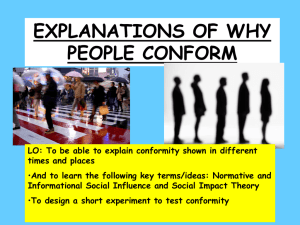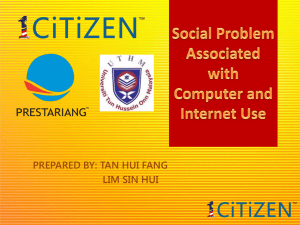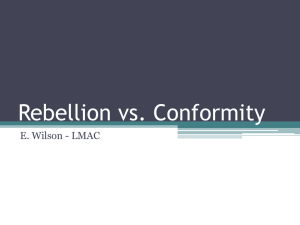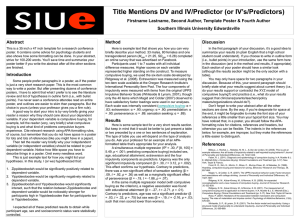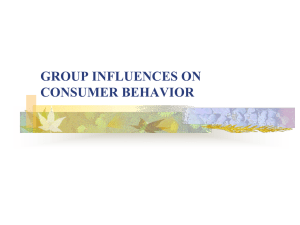ASSOCIATION FOR CONSUMER RESEARCH
advertisement
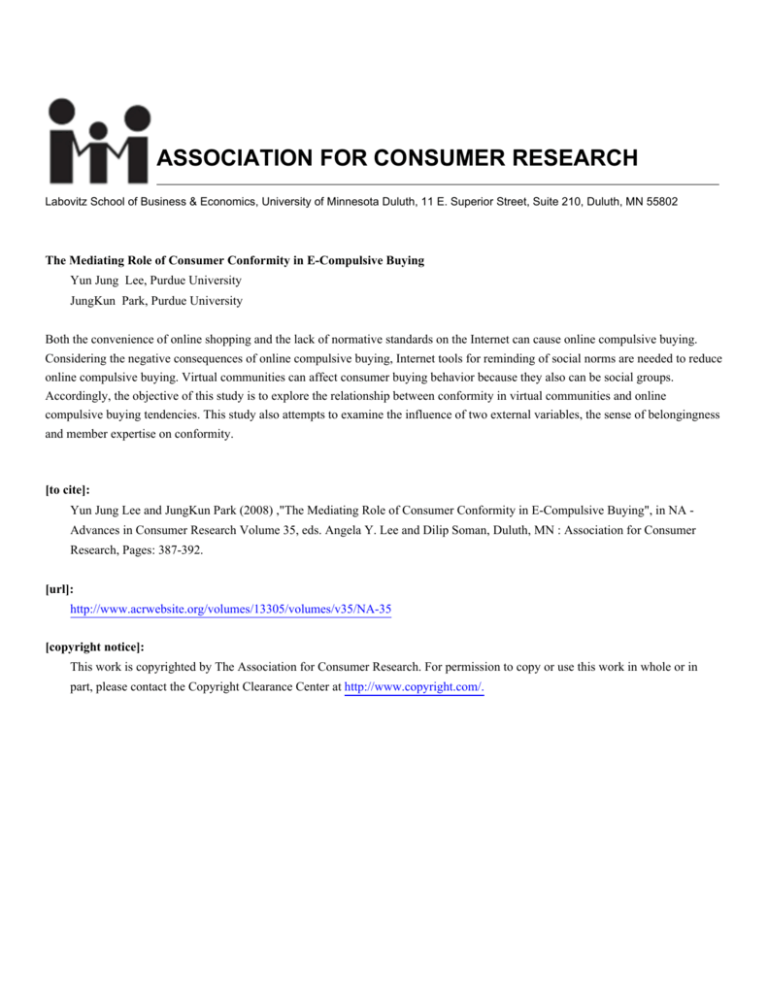
ASSOCIATION FOR CONSUMER RESEARCH Labovitz School of Business & Economics, University of Minnesota Duluth, 11 E. Superior Street, Suite 210, Duluth, MN 55802 The Mediating Role of Consumer Conformity in E-Compulsive Buying Yun Jung Lee, Purdue University JungKun Park, Purdue University Both the convenience of online shopping and the lack of normative standards on the Internet can cause online compulsive buying. Considering the negative consequences of online compulsive buying, Internet tools for reminding of social norms are needed to reduce online compulsive buying. Virtual communities can affect consumer buying behavior because they also can be social groups. Accordingly, the objective of this study is to explore the relationship between conformity in virtual communities and online compulsive buying tendencies. This study also attempts to examine the influence of two external variables, the sense of belongingness and member expertise on conformity. [to cite]: Yun Jung Lee and JungKun Park (2008) ,"The Mediating Role of Consumer Conformity in E-Compulsive Buying", in NA Advances in Consumer Research Volume 35, eds. Angela Y. Lee and Dilip Soman, Duluth, MN : Association for Consumer Research, Pages: 387-392. [url]: http://www.acrwebsite.org/volumes/13305/volumes/v35/NA-35 [copyright notice]: This work is copyrighted by The Association for Consumer Research. For permission to copy or use this work in whole or in part, please contact the Copyright Clearance Center at http://www.copyright.com/. The Mediating Role of Consumer Conformity in E-compulsive Buying Yun Jung Lee, Purdue University, USA JungKun Park, Purdue University, USA ABSTRACT Both the convenience of online shopping and the lack of normative standards on the Internet can cause online compulsive buying. Considering the negative consequences of online compulsive buying, Internet tools for reminding consumers of social norms are needed to reduce online compulsive buying. Virtual communities can affect consumer buying behavior because they also can be social groups. Accordingly, the objective of this study is to explore the relationship between conformity in virtual communities and online compulsive buying tendencies. This study also attempts to examine the influence of two external variables, member expertise and the sense of belongingness on conformity. INTRODUCTION As the Internet has developed, more consumers have been enjoying online shopping. While the Internet serves as a convenient way to shop, the convenience of the Internet also causes some negative effects on consumers. For example, consumers might experience unregulated consumption behavior when they shop online. One of the uncontrolled consumption behaviors on the Internet is compulsive buying. Compulsive buying can be defined as chronic, repetitive, and excessive buying as a result of negative events or feelings (O’Guinn and Faber 1989). Compulsive buying might cause consumers to suffer from economic and/or psychological problems. For example, compulsive buyers are inclined to spend more money than they have, and this excessive spending can destroy their own and their families’ lives (D’Astous 1990; Faber and O’Guinn 1992). In addition, although consumers have shortterm positive feelings after compulsive buying, they experience significantly negative feelings in the long run (Faber and O’Guinn 1989; O’Guinn and Faber 1989). Accordingly, compulsive buyers often return the purchased products (LaRose 2001). Moreover, they might communicate negative feelings about their shopping experience after compulsive buying. Therefore, compulsive buyers are not likely to be welcome customers for retailers in the long run. Thus, it is important to prevent consumers’ compulsive buying for retailers as well as for consumers themselves. Consumers can enjoy shopping via the Internet with relatively low social interaction. This lack of interaction and social environment can also affect consumers’ online compulsive buying. Previous studies in social psychology found that important others such as peer groups and friends may often have significant influence and give information in the attention-directing stage of the buying process (Venkatesan 1966). For example, when we go shopping with friends, we often ask their opinions about what we want to buy. When hearing positive opinions, we are more likely to buy the products. On the other hand, if we hear negative information about the products, we are reluctant to purchase them. Furthermore, based on previous studies in consumer behavior, it is clear that social norms have an effect on compulsive buying (Lee, Lennon, and Rudd 2000; Schlosser et al. 1994). Accordingly, it is not surprising that compulsive buyers don’t want to be alarmed by others, which would cause the compulsive buyers to become aware of their compulsiveness and would prevent them from buying unnecessary products. For this reason, the Internet might be a preferable place for compulsive buyers to purchase what they want without being interrupted by normative standards for buying (LaRose 2001). Considering both the negative outcomes of online compulsive buying for both retailers and consumers and the lack of reminders of normative standards for buying on the Internet, tools for reminding consumers of social norms on the Internet are needed to reduce online compulsive buying. Then, what could play the role of important others like friends and families when consumers shop online? Where is the place for consumers to interact with others on the Internet? The virtual community is a place to meet others and share their opinions on the Internet through networking. Thus, this study examines the role of virtual communities in online compulsive buying: whether virtual communities discourage online compulsive buying or not. For this objective, the study explores the relationship between conformity in virtual communities and online compulsive buying tendencies. This study also attempts to examine the influence of two external variables, the sense of belongingness and member expertise on conformity. LITERATURE REVIEW Online Compulsive Buying In general, compulsion refers to “repetitive and seemingly purposeful behaviors that are performed according to certain rules or in a stereotyped fashion” (American Psychiatric Association 1985). On the other hand, compulsive buying includes the meaning of excessive buying or out-of-control buying (Faber, O’Guinn, and Krych 1987). Compulsive buying also can be defined as “chronic, repetitive purchasing that becomes a primary response to negative events or feelings” according to previous studies (O’Guinn and Faber 1989). Compulsive buying does not simply result from one simple factor. In fact, many researchers have tried to examine factors which result in compulsive buying, and they agree that it may result from multiple factors (Faber 1992). Among others, Faber and Christenson (1996) suggested biochemical, social, and psychological factors. One major gap in the research is a lack of empirical studies dedicated to measuring and exploring the topic of online compulsive buying. However, the unique characteristics of online shopping like high accessibility, much inventory, and attractive online displays have been thought to increase online compulsive buying (Eastin 2002). Moreover, many compulsive buyers want to avoid being reminded of normative standards, by important others (LaRose 2001). Accordingly, they tend to shop alone, at night, or through home shopping channels (Lee et al. 2000; Schlosser et al. 1994). Therefore, online shopping can be the best way for compulsive buyers to shop in isolated shopping environments. Virtual Community and Conformity Rheingold (1994, 57–58) defined a virtual community as ‘‘social aggregations that emerge from the Net when enough people carry on those public discussions long enough, with sufficient human feelings, to form webs of personal relationships in cyberspace. A virtual community is a group of people who may or may not meet one another face to face, and who exchange words and ideas through the mediation of computer bulletin boards and networks.’’ Similarly, Romm, Pliskin, and Clarke (1997) defined a virtual community as a group of people who communicate with one 387 Advances in Consumer Research Volume 35, © 2008 388 / The Mediating Role of Consumer Conformity in E-compulsive Buying another via electronic media and share common interests unconstrained by their geographical location, physical interaction or ethnic origin. More recently, Ridings, Gefen, and Arinze (2002) defined a virtual community as a group of people with common interests and practices that communicate regularly for some duration in an organized way over the Internet through a common location or mechanism. Based on these definitions, it is assumed that a virtual community is a source of social influence on the Internet. Since people do live with others, their behavior influences others. This social influence has been identified as conformity. While Allen (1965) defined conformity as one manifestation of social influence due to the opposition of the other group members to an individual’s views, Burnkrant and Cousineau (1975) defined conformity as the tendency of opinions to establish a group norm as well as the tendency of individuals to comply with the group norm. While normative conformity has been more emphasized, the dichotomy of conformity has been represented by a dual process dependency model of social influence (Pendry and Carrick 2001). Deutsch and Gerard (1955) asserted that conformity consists of two categories, informative and normative conformity motivations. They define informational conformity as the influence to accept information from others to evince the truth of reality. On the other hand, they refer to normative conformity as the influence to conform to the expectations of others. Consumers consider that the information from a group is credible when the group has expertise (Kelman 1961). According to previous studies, consumers might internalize and manifest information from others when they can believe others’ expertise (Kelman 1961; McGuire 1969). H1: Member expertise has a positive relationship with informative conformity. H2: Member expertise has a positive relationship with normative conformity. Furthermore, it is believed that the role of group belongingness in conformity is more important than classical explanations had assumed (Pendry and Carrick 2001). Luo (2005) found that the influence of peers or family is greater when the group is more cohesive. H3: Sense of belongingness has a positive relationship with informative conformity. H4: Sense of belongingness has a positive relationship with normative conformity. Informative conformity affects consumers’ buying behavior. Consumers search for information when they buy products or services. While word-of-mouth has been considered a major factor in consumers’ buying decisions (Richins and Root-Shaffer 1988), the rapid development of the Internet has extended the place of word-of-mouth from offline to online. Considering that consumers cannot see and touch the real product on the Internet, information from others who have already experienced that product might be critical for consumers. Normative conformity also plays an important role in consumers’ buying behavior. Consumers sometimes feel responsibility to respond to concerns of what others thought or how others reacted to their product choice and usage (Calder and Burnkrant 1977). Consumers even observe others’ purchasing behavior in order to check whether their own purchase is acceptable in society (Bearden, Netemeyer, and Teel 1989). According to Luo’s experimental study (2005), while the presence of peers increases impulsive purchasing, the presence of family members decreases it. H5: Informative conformity has a negative relationship with e-compulsive buying. H6: Normative conformity has a negative relationship with ecompulsive buying. METHODOLOGY To accomplish the research objective, an online survey was conducted to collect data. Two thousand e-mail invitations were distributed to a randomly selected national sample purchased from an independent research company. A total of 302 respondents participated, representing a 15.1 % response rate. Furthermore, the panel members were limited to those who engage in at least one virtual community, and the usable sample was 179 after the screening process. Sample Characteristics are presented in table 1. The measures in this study were adopted from previous studies. The questionnaire consists of these tendencies: member expertise, a sense of belongingness, online consumer conformity, and online compulsive buying. Member expertise was developed based on a fifteen-item scale which was initially a consumer expertise measure (Kleiser and Mantel 1994). A sense of belongingness was measured using a three-item scale (Kember and Leung 2004). After purification, only 10 items were used. Online consumer conformity was measured using a twelve-item scale (Bearden et al. 1989). We developed an online compulsive buying measure based on a compulsive buying measure in the previous study (Faber and O’Guinn 1992). Before conducting structural equation modeling, a confirmatory factor analysis was used to verify the measurements. In addition, all of the final multiple scales in this study demonstrate high reliability (table 2). RESULTS The proposed conceptual model (figure 1) was tested by using structural equation modeling. The fit of the overall measurement model was estimated by various indices. The results indicate an excellent fit of data for our conceptual model (table 3). The path coefficients are presented in table 4. According to the results, member expertise has a positive impact on both informative and normative conformity and supports hypotheses 1 and 2. About the strength of the relationship, member expertise has a stronger influence on informative conformity than on normative conformity. Sense of belongingness also has positive influences on both informative and normative conformity. Therefore, hypotheses 3 and 4 are supported as well. However, the strength of the relationship between sense of belongingness and conformity shows a different pattern from the relationship between member expertise and conformity. Sense of belongingness has more influence on normative conformity than on informative conformity. In sum, both member expertise and sense of belongingness have positive influences on both informative and normative conformity. In contrast, while member expertise has more influence on informative conformity, sense of belongingness has more influence on normative conformity. The hypothesized relationship between informative conformity and online compulsive buying tendencies was not significant. Thus, hypothesis 5 was not supported. Finally, the relationship between normative conformity and online compulsive buying tendencies is supported by the results of this study. Concerning the direction of the relationship, the negative relationship is also confirmed between normative conformity and online compulsive buying tendencies. It means people more likely to have normative Advances in Consumer Research (Volume 35) / 389 FIGURE 1 Conceptual Model TABLE 1 Demographic Characteristics of Respondents (n=179) Frequency % Gender Male Female 70 109 39.1 % 60.9 % Age 18-24 years 25-39 years 40-59 years 60 years or older 13 70 78 18 7.3 % 39.1 % 43.6 % 10.1 % Income Less than $10,000 $10,000-$24,999 $25,000-$39,999 $40,000-$59,999 $60,000-$100,000 More than $100,000 4 5 22 40 53 55 2.2 % 2.8 % 12.3 % 22.3 % 29.6 % 30.7 % Ethnicity Caucasian Asian African American Hispanic Other 154 10 3 3 9 86.0 % 5.6 % 1.7 % 1.7 % 5.0 % conformity with members in a virtual community are less likely to be online compulsive buyers. DISCUSSION While compulsive buyers should consider social norms when they purchase something offline, online shopping gives more isolated shopping environments to consumers. Thus, the purpose of this study was to examine the role of virtual communities on online compulsive buying tendencies. This study examined the relationship between normative and informative conformity in virtual communities and online compulsive buying tendencies. It also confirmed the influence of two external variables, member expertise and the sense of belongingness on conformity in virtual communities. The positive relationship between member expertise and conformity in virtual communities means that consumers have higher 390 / The Mediating Role of Consumer Conformity in E-compulsive Buying TABLE 2 Summary of Measurement Scales Construct Member Expertise Measures The virtual community members enjoy learning about the product/service I sought advice about. α .944 The members of the virtual community are knowledgeable about the product/service. The members of the virtual community are familiar with almost all existing brands of the product/service. The virtual community members search for the latest information on this product/service before purchasing. The virtual community members' knowledge of this product/service helps them to understand very technical information about it. The virtual community members can recognize almost all brand names of this product/service. The members of the virtual community keep current on the most recent developments of this product/service. Virtual community members use their knowledge of this product/service to verify that advertising claims are in fact true. Virtual community members can recall product-specific attributes of this product/service. Virtual community members can recall brand-specific attributes of the various brands of this product/service. Sense of Belongingness I feel a sense of belonging to my virtual community. .831 I am able to relate to the virtual community. I feel that I have established a relationship with the virtual community. Online Consumer Conformity I often consult others in the virtual community to help choose the best alternative available. .900 If I want to be like someone in the virtual community, I often try to buy the same brands that they buy. It is important that others in the virtual community like the products and brands I buy. To make sure I buy the right product or brand, I often observe what others in the virtual community are buying and using. I rarely purchase the latest fashion styles until I am sure the virtual community approves of them. I often identify with others in the virtual community by purchasing the same brands they purchase. If I have little experience with a product/service, I often ask the virtual community about it. When buying products/services, I generally purchase those brands that I think the virtual community would approve of. I like to know what brands and products make good impressions on the virtual community. I frequently gather information from the virtual community about a product/service before I buy. If other people can see me using a product/service, I often purchase the brand the virtual community expects me to buy. I achieve a sense of belonging by purchasing the same products and brands that the virtual community purchases. Online Compulsive Buying I felt others would be horrified if they knew my online spending habits. I bought things online even though I couldn't afford them. I bought something online when I knew I didn't have enough money in the bank to cover it. I bought something online in order to make myself feel better. I felt anxious or nervous on days I didn't shop online. I made only the minimum payments on my credit cards. If I have any money left at the end of the pay period, I just have to spend it online. .854 Advances in Consumer Research (Volume 35) / 391 TABLE 3 Fit Analysis Fit Measures Fit Guidelines Proposed Model χ2/df GFI AGFI TLI CFI RMSEA ≤3.0 ≥.90 ≥.80 ≥.90 ≥.90 ≤.08 1.596 .896 .861 .944 .953 .058 TABLE 4 Path Coefficient Paths Estimate Member Expertise → Informative Conformity .560*** Member Expertise → Normative Conformity .499*** Sense of Belongingness → Informative Conformity .342*** Sense of Belongingness → Normative Conformity .470*** Informative Conformity → Online Compulsive Buying Tendencies NS Normative Conformity → Online Compulsive Buying Tendencies - .196 ** * p<.05 ** p<.01 *** p<.001 conformity when they perceive the members in a virtual community have expertise. It can be supported by a previous offline study confirming that a consumer’s belief in the credibility of the information from a group depends on the group members’ expertise (Kelman 1961). The results of this study also confirm Pendry and Carrick’s (2001) suggestion that belongingness should be considered more important in conformity. As Luo (2005) found that social influence is greater when the group is more cohesive, consumers showed more conformity when they felt more sense of belongingness. Another interesting finding in this study was that while normative conformity in virtual communities has a significant effect on online compulsive buying, informative conformity has no effect on online compulsive buying. The negative relationship between normative conformity and online compulsive buying is consistent with many previous studies showing social norms have a negative relationship with compulsive buying (Lee et al. 2000; Schlosser et al. 1994). Although informative conformity on the Internet (e.g., online word-of-mouth) might affect normal consumers’ buying decisions (Richins and Root-Shaffer 1988), it is not related to online compulsive buying. It can be explained by the fact that compulsive buying is unplanned behavior without much information search. The results of this study confirm the possibility of virtual communities playing an important role in preventing compulsive buying by reminding consumers of social norms. Therefore, online stores, like virtual communities, can also provide consumer reviews not only to give information but also to prevent online compulsive buying. As indicated in this study, consumers who feel a greater sense of belongingness in a virtual community have greater normative conformity, thus showing less online compulsive buying tendencies. Consequently, it is important to maintain a virtual community where members can feel belongingness. In this study, we used a broad concept of virtual communities to obtain data. However, there are many kinds of undefined virtual communities in the real world with different characteristics. Thus, future research needs to examine whether the role of a virtual community in online compulsive buying is different across various virtual communities. REFERENCES Allen, Vernon L. (1965), “Situational Factors in Conformity,” in Advances in Experimental and Social Psychology, Vol. 2, ed. Leonard Berkowitz, New York, NY: Academic Press, 133– 75. American Psychiatric Association (1985), Diagnostic and Statistical Manual of Mental Disorders, Washington, DC: American Psychiatric Association. 392 / The Mediating Role of Consumer Conformity in E-compulsive Buying Bearden, William O., Richard G. Netemeyer, and Jesse E. Teel (1989), “Measurement of Consumer Susceptibility to Interpersonal Influence,” Journal of Consumer Research, 15 (4), 473–81. Burnkrant, Robert E. and Alain Cousineau (1975), “Informational and Normative Social Influence in Buyer Behavior,” Journal of Consumer Research, 2 (3), 206–15. Calder, Bobby J. and Robert E. Burnkrant (1977), “Interpersonal Influence on Consumer Behavior: An Attribution Theory Approach,” Journal of Consumer Research, 4 (1), 29–38. D’Astous, Alain (1990), “An Inquiry into the Compulsive Side of Normal Consumers,” Journal of Consumer Policy, 13 (1), 15–30. Deutsch, Morton and Harold B. Gerard (1955), “A Study of Normative and Informational Social Influences upon Individual Judgment,” Journal of Abnormal Social Psychology, 51 (3), 629–36. Eastin, Matthew S. (2002), “Diffusion of E-Commerce: An Analysis of the Adoption of Four E-Commerce Activities,” Telematics and Infomatics, 19 (3), 251–67. Faber, Ronald J. (1992), “Money Changes Everything: Compulsive Buying from Biopsychosocial Perspective,” American Behavioral Scientist, 35 (6), 809–19. Faber, Ronald J. and Gary A. Christenson (1996), “In the Mood to Buy: Differences in the Mood States Experienced by Compulsive Buyers and Other Consumers,” Psychology & Marketing, 13 (8), 803–19. Faber, Ronald J. and Thomas C. O’Guinn (1989), “Classifying Compulsive Consumers: Advances in the Development of a Diagnostic Tool,” in Advances in Consumer Research, Vol. 16, ed. Thomas K. Srull, Provo, UT: Association for Consumer Research, 738–44. (1992), “A Clinical Screener for Compulsive Buying,” Journal of Consumer Research, 19 (3), 459–69. Faber, Ronald J., Thomas C. O’Guinn, and Raymond Krych (1987), “Compulsive Consumption,” in Advances in Consumer Research, Vol. 14, ed. Melanie Wallendorf and Paul F. Anderson, Provo, UT: Association for Consumer Research, 132–35. Kelman, Herbert C. (1961), “Processes of Opinion Change,” Public Opinion Quarterly, 25 (1), 57–78. Kember, David and Doris Y. P. Leung (2004), “Relationship between the Employment of Copying Mechanisms and a Sense of Belonging for Part-Time Students,” Educational Psychology, 24 (3), 345–57. Kleiser, Susan B. and Susan P. Mantel (1994), “The Dimensions of Consumer Expertise: A Scale Development,” in AMA Summer Educators’ Proceedings, Vol. 5, ed. Ravi Achrol and Andrew Mitchell, Chicago, IL: American Marketing Association, 20–26. LaRose, Robert (2001), “On the Negative Effects of E-Commerce: A Sociocognitive Exploration of Unregulated On-line Buying,” Journal of Computer-Mediated Communication, 6 (3), http://jcmc.indiana.edu/vol6/issue3/larose.html. Lee, Seung-Hee, Sharron J. Lennon, and Nancy A. Rudd (2000), “Compulsive Consumption Tendencies among Television Shoppers,” Family and Consumer Sciences Research Journal, 28 (4), 463–88. Luo, Xueming (2005), “How Does Shopping with Others Influence Impulsive Purchasing?” Journal of Consumer Psychology, 15 (4), 288–94. McGuire, William J. (1969), “The Nature of Attitudes and Attitude Change,” in The Handbook of Social Psychology, Vol. 3, ed. Gardner Lindzey and Elliot Aronson, Reading, MA: Addison-Wesley, 372–98. O’Guinn Thomas C. and Ronald J. Faber (1989), “Compulsive Buying: A Phenomenological Exploration,” Journal of Consumer Research, 16 (2), 147–57. Pendry, Louise and Rachael Carrick (2001), “Doing What the Mob Do: Priming Effects on Conformity,” European Journal of Social Psychology, 31 (1), 83–92. Rheingold, Howard (1994), “A Slice of Life in My Virtual Community,” in Global Networks: Computers and International Communication, ed. Linda M. Harasim, Cambridge, MA: MIT Press, 57–80. Richins, Marsha L. and Teri Root-Shaffer (1988), “The Role of Involvement and Opinion Leadership in Consumer Word-ofMouth: An Implicit Model Made Explicit,” Advances in Consumer Research, Vol. 15, ed. Michael J. Houston, Provo, UT: Association for Consumer Research, 32–36. Ridings, Catherine M., David Gefen, and Bay Arinze (2002), “Some Antecedents and Effects of Trust in Virtual Communities,” Journal of Strategic Information Systems, 11 (3–4), 271–95. Romm, Celia, Nava Pliskin, and Rodney Clarke (1997), “Virtual Communities and Society: Toward an Integrative Three Phase Model,” International Journal of Information Management, 17 (4), 261–70. Schlosser, Steven, Donald W. Black, Susan Repertinger, and Daniel Freet (1994), “Compulsive Buying: Demography, Phenomenology, and Comorbidity in 46 Subjects,” General Hospital Psychiatry, 16 (3), 205–12. Ventatesan, M. (1966), “Experimental Study of Consumer Behavior Conformity and Independence,” Journal of Marketing Research, 3 (4), 384–87.



